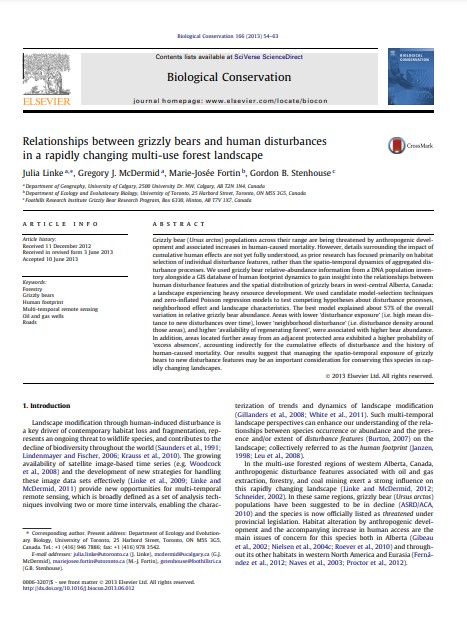Relationships between grizzly bears and human disturbances in a rapidly changing multi-use forest landscape
Bosque Modelo:
Foothills
Temática:
Desarrollo humano
Tipo de documento:
Artículo científico
Resumen
Grizzly bear (Ursus arctos) populations across their range are being threatened by anthropogenic development and associated increases in human-caused mortality. However, details surrounding the impact of cumulative human effects are not yet fully understood, as prior research has focused primarily on habitat selection of individual disturbance features, rather than the spatio-temporal dynamics of aggregated disturbance processes. We used grizzly bear relative-abundance information from a DNA population inventory alongside a GIS database of human footprint dynamics to gain insight into the relationships between human disturbance features and the spatial distribution of grizzly bears in west-central Alberta, Canada: a landscape experiencing heavy resource development. We used candidate model-selection techniques and zero-inflated Poisson regression models to test competing hypotheses about disturbance processes, neighborhood effect and landscape characteristics. The best model explained about 57% of the overall variation in relative grizzly bear abundance. Areas with lower ‘disturbance exposure’ (i.e. high mean distance to new disturbances over time), lower ‘neighborhood disturbance’ (i.e. disturbance density around those areas), and higher ‘availability of regenerating forest’, were associated with higher bear abundance. In addition, areas located further away from an adjacent protected area exhibited a higher probability of ‘excess absences’, accounting indirectly for the cumulative effects of disturbance and the history of human-caused mortality. Our results suggest that managing the spatio-temporal exposure of grizzly bears to new disturbance features may be an important consideration for conserving this species in rapidly changing landscapes.
Información Bibliográfica
Autor:
Linke, J., McDermid, G.J., Fortin, M.-J., & Stenhouse, G.B.
Revista:
Biological Conservation
Año:
2013
N°:
-
País :
Canadá
Páginas:
54 - 63
Volumen:
166
Idioma:
Ingles
Palabras claves
Forestry Grizzly bears Human footprint Multi-temporal remote sensing Oil and gas wells Roads





